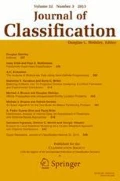Abstract
Given two dendrograms (rooted tree diagrams) which have some but not all of their base points in common, a supertree is a dendrogram from which each of the original trees can be regarded as samples The distinction is made between inconsistent and consistent sample trees, defined by whether or not the samples provide contradictory information about the supertree An algorithm for obtaining the strict consensus supertree of two consistent sample trees is presented, as are procedures for merging two inconsistent sample trees Some suggestions for future work are made
Similar content being viewed by others
References
ADAMS, E N (1972), “Consensus Techniques and the Comparison of Taxonomic Trees,”Systematic Zoology, 21, 390–397
DAY, W H E (1985), “Optimal Algorithms for Comparing Trees with Labeled Leaves,”Journal of Classification, 2, 7–28
FINDEN, C R, and GORDON, A D (1985), “Obtaining Common Pruned Trees,”Journal of Classification, 2, 255–276
GORDON, A D (1980), “On the Assessment and Comparison of Classifications,” inAnalvse de Données et Informatique, Ed R Tomassone, Le Chesnay: INRIA, 149–160
HARDING, E F (1971), “The Probabilities of Rooted Tree-Shapes Generated by Random Bifurcation,”Advances in Applied Probability, 3, 44–77
McMORRIS, F R, MERONK, D B, and NEUMANN, D A (1983), “A View of Some Consensus Methods for Trees,” inNumerical Taxonomy, Ed J Felsenstein Berlin: Springer-Verlag, 122–126
MAIER, D (1978), “The Complexity of Some Problems on Subsequences and Supersequences,”Journal of the Association for Computing Machinery, 25, 322–336
MARGUSH, T, and McMORRIS, F R (1981), “Consensus n-Trees,”Bulletin of Mathematical Biology, 43, 239–244
MURTAGH, F (1984), “Counting Dendrograms: A Survey,”Discrete Applied Mathematics, 7, 191–199
NEUMANN, D A (1983), “Faithful Consensus Methods for n-Trees,”Mathematical Biosciences, 63, 271–287
PHIPPS, J B (1976), “The Numbers of Classifications,”Canadian Journal of Botany, 54, 686–688
SIBSON, R (1972), “Order Invariant Methods for Data Analysis,”Journal of the Royal Statistical Society, Series B, 34, 311–349
SNEATH, P H A (1983), “Philosophy and Method in Biological Classification,” inNumerical Taxonomy, Ed J Felsenstein, Berlin: Springer-Verlag, 22–37
SOKAL, R R, and ROHLF, F J (1981), “Taxonomic Congruence in the Leptopodomorpha Re-examined,”Systematic Zoology, 30, 309–325
STINEBRICKNER, R (1984), “s-Consensus Trees and Indices,”Bulletin of Mathematical Biology, 46, 923–935
Author information
Authors and Affiliations
Rights and permissions
About this article
Cite this article
Gordon, A. Consensus supertrees: The synthesis of rooted trees containing overlapping sets of labeled leaves. Journal of Classification 3, 335–348 (1986). https://doi.org/10.1007/BF01894195
Issue Date:
DOI: https://doi.org/10.1007/BF01894195




